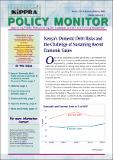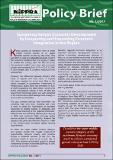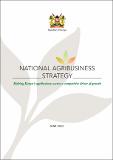| dc.date.accessioned | 2021-02-26T12:46:36Z | |
| dc.date.available | 2021-02-26T12:46:36Z | |
| dc.date.issued | 2004 | |
| dc.identifier.uri | http://repository.kippra.or.ke/handle/123456789/2719 | |
| dc.description | A policy monitor addressing the challenges of the domestic debt in Kenya and strategies to reduce the domestic debt in the 2004/2005 financial year. | en |
| dc.description.abstract | One of the fundamental public goods that a government can
provide to its citizens is a stable macroeconomic environment
supported by prudent fiscal policies. Prudent fiscal policies
enable the government to, among other things, run a sustainable debt.
Debt service payments are usually made at the expense of essential or
productive public spending. In the Poverty Reduction Strategy
Paper (PRSP) adopted in 2000, the
government set a target of containing
domestic debt at 15 percent of GDP
by 2003/04. This was to be achieved
by maintaining an overall framework
of budget surpluses or minimal
deficit, scaling back reliance on
Treasury bills as a budget financing
instrument, developing long-term
financial instruments, reversing the
net outflows reflected in the external
debt repayment, and by restricting
borrowing to external concessional
terms. However, this target has not
been achieved... | en |
| dc.language.iso | en | en |
| dc.publisher | The Kenya Institute for Public Policy Research and Analysis | en |
| dc.relation.ispartofseries | Policy Monitor Issue 1 No.3 January-March 2004; | |
| dc.subject | Domestic debt | en |
| dc.subject | Risk Analysis | en |
| dc.subject | Economic gains | en |
| dc.subject | Gross Domestic Product | en |
| dc.subject | Fiscal strategy | en |
| dc.subject | Economic recovery strategy | en |
| dc.title | Policy Monitor, Issue 1 No. 3, January-March 2004 on Kenya's Domestic Debt: Risks and the Challenge of Sustaining Recent Economic Gains | en |
| dc.type | KIPPRA Publications | en |
| ppr.contributor.author | Kenya Institute for Public Policy Research and Analysis (KIPPRA) | en |




